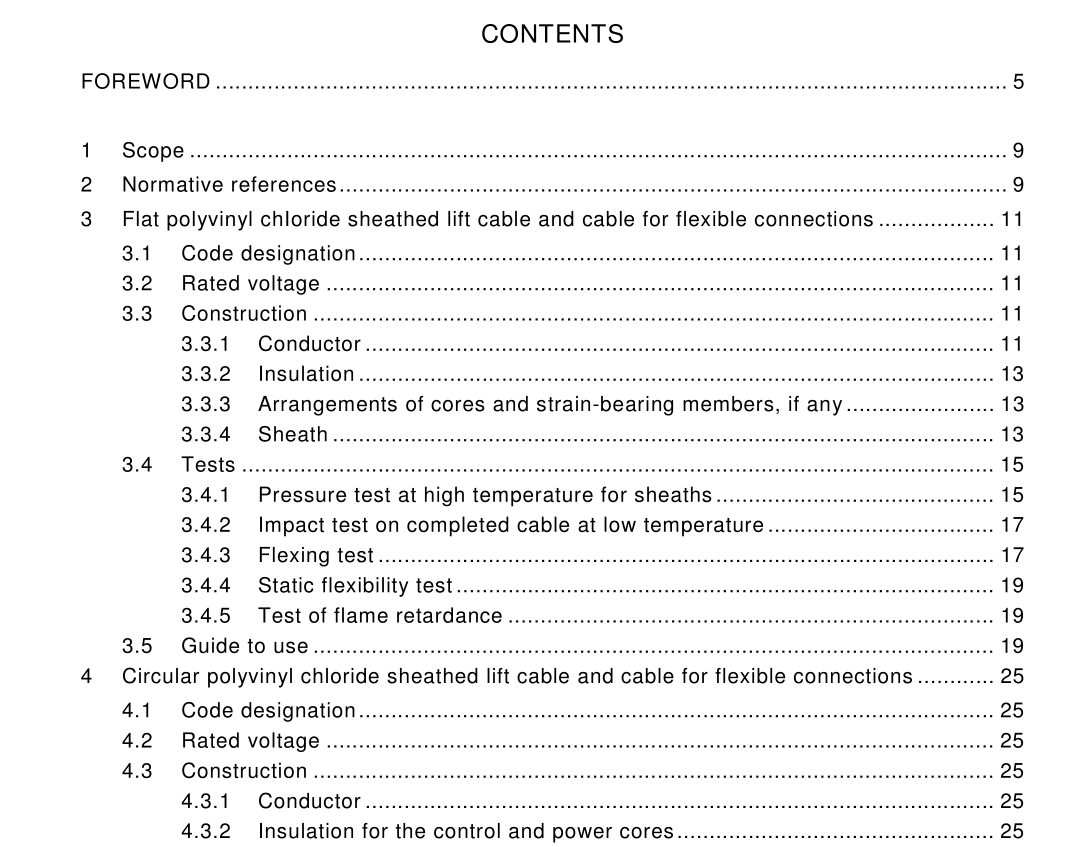IEC 60227-6 pdf download

IEC 60227-6 pdf download.Polyvinyl chloride insulated cables of rated voltages up to and including 450/750 V
1 Scope
This part of IEC 60227 details the particular specifications for both circular and flat lift cables and cables for flexible connections of rated voltages up to and including 450/750 V. Each cable complies with the appropriate requirements given in IEC 60227-1, and with the particular requirements of this part of IEC 60227.
2 Normative references
The following normative documents contain provisions which, through reference in this text, constitute provisions of this part of IEC 60227. For dated references, subsequent amend- ments to, or revisions of, any of these publications do not apply. However, parties to agreements based on this part of IEC 60227 are encouraged to investigate the possibility of applying the most recent editions of the normative documents indicated below. For undated references, the latest edition of the normative document referred to applies. Members of IEC and ISO maintain registers of currently valid International Standards. IEC 60096-0-1:1990, Radio-frequency cables – Part 0-1: Guide to the design of detailed specifications – Coaxial cables 1 IEC 60227-1:1993, Polyvinyl chloride insulated cables of rated voltages up to and including 450/750 V – Part 1: General requirements 2 IEC 60227-2:1997, Polyvinyl chloride insulated cables of rated voltages up to and including 450/750 V – Part 2: Test methods IEC 60228:1978, Conductors of insulated cables IEC 60332-1:1993, Tests on electric cables under fire conditions – Part 1: Test on a single vertical insulated wire or cable
The conductors shall comply with the requirements given in IEC 60228 for class 5 conductors. The conductors of the cores in the side position may consist of copper wires and steel wires. The nominal geometric cross-sectional area of these conductors shall be equal to that of the other conductors and the maximum resistance shall be not more than twice the maximum resistance of a copper conductor of the same nominal cross-sectional area. 3.3.2 Insulation The insulation shall be polyvinyl chIoride compound of type PVC/D applied around each conductor. The insulation thickness shall comply with the specified value given in table 4, column 2. The insulation resistance shall be not less than the value given in table 4, column 3. 3.3.3 Arrangements of cores and strain-bearing members, if any The cores shall be laid parallel. It is permitted, however, that two, three, four or five cores may be laid in groups; in such cases, a tearing thread may be inserted inside each group. It shall be possible to separate the cores without damage to the insulation. Strain-bearing member(s) of textile material may be used. A strain-bearing member (or members) of metal may also be used; in such a case (cases) it (they) shall be covered with a non-conducting abrasion-resistant material.The nominal value of the clearance e, separating the groups is given in table 5, column 2 (see also figure 1). There is no requirement for the mean value of the clearance e 1 . However, any clearance separating the groups may be less than the nominal value e 1 provided that the difference does not exceed 0,2 mm + 20 % of the nominal value. 3.3.4 Sheath The sheath shall be a polyvinyl chIoride compound of type PVC/ST5 applied around the cores. The sheath shall be applied so as to substantially avoid the formation of cavities, and shall not adhere to the cores. The edges of the cable shall be rounded off.
3.4 Tests
Compliance with the requirements of 3.3 shall be checked by inspection and by the tests given in table 6 except that, owing to the rectangular cross-section of the cable, the following modifications and additions shall be taken into account. Where applicable, 3.4.1 to 3.4.5 inclusive shall be read in conjunction with the relevant tests specified in table 6. 3.4.1 Pressure test at high temperature for sheaths If the smaller sides of the cable are fully rounded in shape, this test shall be carried out on one of the smaller sides in accordance with 8.2 of IEC 60811-3-1. To calculate the compressing force, D is the minor dimension of the cable and δ is the mean sheath thickness e 3 as determined in 8.1.4 of IEC 60811-1-1. If the smaller sides are flat, or nearly flat, as depicted in figure 1, this test shall be carried out in accordance with 8.2 of IEC 60811-3-1, with the method modified as follows: a) Preparation of test piece A strip shall be cut from the wide side of the cable in the direction of the axis of the cable. On the inner side, only the ridges shall be removed by grinding or cutting. The width of the strip to be tested shall be at least 10 mm but not more than 20 mm. The thickness of the strip shall be measured at the place where the compressing force F is applied. b) Position of test piece in the test apparatus The strip shall be bent around a mandrel having a diameter approximately equal to the diameter of the core of the cable; the longitudinal axis of the strip shall be perpendicular to the axis of the mandrel. Provision shall be made that the inner surface of the strip shall be in contact over at least 120° of the circumference of the mandrel (see figure 2). The metal blade of the test apparatus shall be placed on the middle of the test piece.









